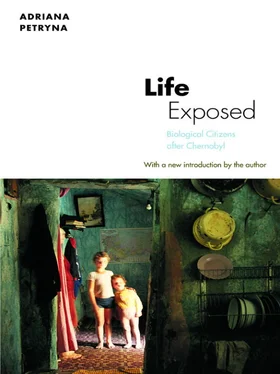Signs of ruin and disintegration abounded. Anton had bundled up items that belonged to Iryna and her husband, making it clear that their things no longer belonged in the house. Once the bag was filled, Halia spent what seemed an interminable time searching for a white envelope containing her identity card and medical book, necessary for the registration of the number of days she spent in the hospital. Her attending physician would register that number so that she would be eligible to receive her salary for those days (the book could also show proof of Halia’s battered condition). To her shock, the envelope she found was empty. She held it up and said, “See how smart he is.”
As we left, Halia asked the policeman to help her carry the heavy bag. He apologetically refused. He couldn’t carry it because “if your husband saw me carrying your bags, he could accuse me of stealing his property.” I helped her carry the bag as the policeman returned to the militia station. “Ten years ago, I had no reason to associate with the police,” Halia told me. “Their sphere of activity was separate from my sphere of activity. Now I know the name of the policeman, I need his protection.”
Halia spotted a neighbor, another woman who apparently knew of her troubles. “Let him jump, hang, cut himself! Why does he threaten to kill everyone else and not kill himself?!” The conversation ended as we continued to walk to the tram station. Suddenly Halia stopped under a fluorescent streetlight. She was suddenly overcome with nervous tremors that had intensified in her arm and neck. We went to Sasha’s apartment to drop the things off. Halia stayed there that night, as the doors to the hospital were already locked.
A few weeks later, Halia called me from Ivana’s house. She said that the medications and treatments at the hospital were extremely invasive. She had gotten a computerized tomographic brain scan at the Pavlova. The scan showed cerebral scarring. She knew I was leaving Ukraine and wanted to say goodbye. She said she would return to the apartment to live with Anton: “Nothing will come of this, we are back to the same thing. Anton drank himself to nothing. I have no way out of this situation.”
Where could she go except to the apartment cell that the couple jointly owned—the home they had waited years for, and that also sheltered Little Halia. “Nothing changed,” as Halia was apt to tell me in several subsequent letters. When I spoke to Anton last, he told me that the neurologist had suddenly died of a heart attack. “They gave me lifetime,” was the first thing Anton said.
The Chernobyl aftermath is a prism reflecting, containing, and reconfiguring the vexed political-economic, scientific, legal, and social circumstances that characterized this interim period. Lawmakers, radiation scientists, health professionals, and groups of sufferers all stood at different points along the continuum of knowledge production, power, moral sensibility, and self-disclosure. The efforts of scientists and clinicians to continually reformat the Chernobyl event and to localize radiation as a set of concrete and embodied effects, combined with efforts of citizens to gain state protection, effected a social mechanism that appeared to be, or was made to appear as, an impersonal and self-authorizing force. Many personal narratives spoke of its effects in terms of physical crippling. Patients cited it as the cause of their symptoms (“It’s as if something is not letting that leg walk”); as the cause of their speechlessness (“It tugged at my voice”); or as the cause of their emotional distress (“I am not weeping. It weeps by itself”). Bureaucrats cited it in order to invest clinical and research structures with the authority to decipher illness claims (“We can’t stop the illness, the whole state is integrated into it”). Health seemed an impossible goal—technically out of the question. Rather, there was a painful determinacy to the radiation illness. It found new niches in terms of the social relations, identities, and symptoms it produced, superimposed itself on, or assailed.
A surprising finding of this research was that this impersonal force was crafted at every step. The physical reality of the Chernobyl disaster and its sheer magnitude were initially refashioned and refracted through a series of informational omissions, technical strategies, errors, semiempirical models, approximations, international cooperations, and limited interventions. Combined, these practices initially produced a picture of a known, circumscribed, and manageable biological reality. Later, these biological effects were seen as political products; technical unknowns were reshaped in the subsequent Ukrainian period as part of a new biopolitical regime. Informal economies of knowledge, codified symptoms, differential medical access, a continuum of diagnoses, and “Chernobyl ties” were mobilized and began to function as institutions in parallel with the state’s official, legal social protection system. These new resources resembled credit advances, ensuring social protections in the uncertain future for people whose temporal horizons were short. The clinical research process facilitated the naturalization of illnesses in bodies as a matter of “social health.” The deep intrusion of illness into personal lives fostered a type of violence that went beyond the line of what could be policed. There was no place that provided natural immunity from these unnatural and technical forces. Instead, there was a complete breakdown of immunities. This state of total unprotectedness constituted a baseline from which people in this world were refashioning themselves (and their bodies) as persons to be protected by the biopolitical regime in which they now lived.
How much that has been described here happens elsewhere in analogous situations, and how much is peculiar to this place and time, and why? In one sense, this ethnography delineates some similarity between Chernobyl and other large-scale technological disasters. As other anthropologists have shown, the social aftermaths of the Union Carbide chemical disaster in Bhopal and the nuclear attacks on Hiroshima and Nagasaki are inflected by the socioeconomic and political contexts and institutions whose policies have also legitimated or served to rebuild states’ internal bureaucratic mechanisms. Many persons who have survived these large-scale technological disasters have been caught in a long-term and vicious bureaucratic cycle in which they carry the burden of proof of their physical damage while experiencing the risk of being delegitimated in legal, welfare, and medical institutional contexts (Das 1995, Todeschini 1999). That suffering appears to be ongoing in these cases reflects, to some degree, the logic of the legal and state structures through which it is addressed.
One difference between Chernobyl and these other disasters involves the number, physical variability, and duration of the kinds of harmful (in this case radioactive) particles that were released. The disaster is marked by a nonclosure of its biological effects. This means that the spread of health effects is difficult to control and difficult to monitor, so that, along with intermediating social complexities, it is not easy to conceptualize what an end to aftermath may mean. Rather, what we have seen established are a series of containments. Different states, political and economic interests, and sciences have taken up these containment processes in ways that have revealed variable ethical commitments and human tolls. This variability in itself suggests not only the intensely political nature of science, but the extent to which the very scientific and political construction of aftermath can affect its lived experiences. These processes, as I have shown, have produced their own spiraling effects, disrupting family lives, creating senses of injustice and insecurity, and shaping individual prospects and interpersonal and political transactions. Those effects become so deeply entrenched that they come to define the fabric of human health: the dimensions that protect or undermine it, and the ethical commitments informing its value and responsibilities.
Читать дальше












